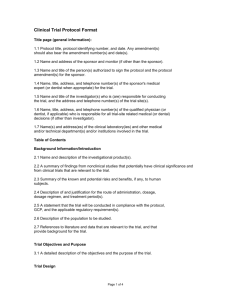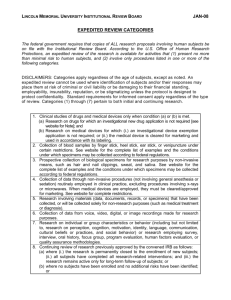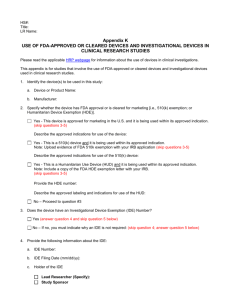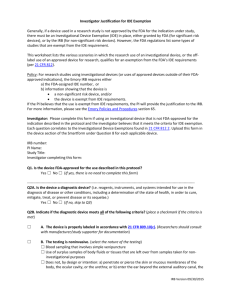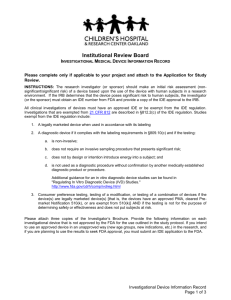HRP-913 Standard Operating Procedure for Investigational Devices
advertisement
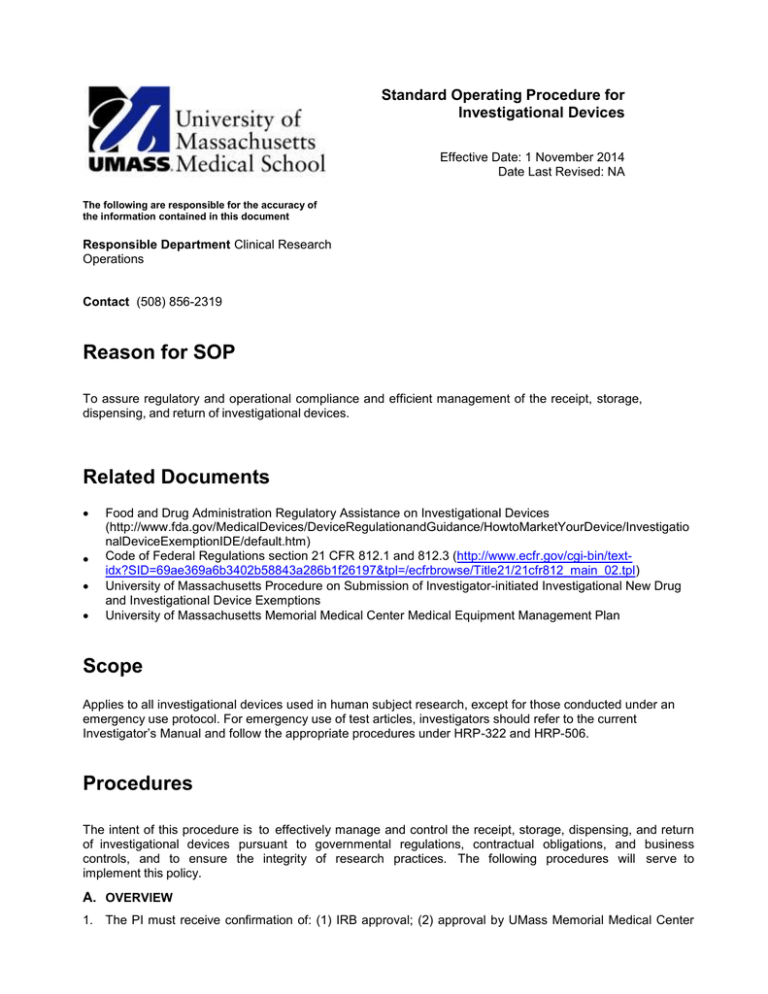
Standard Operating Procedure for Investigational Devices Effective Date: 1 November 2014 Date Last Revised: NA The following are responsible for the accuracy of the information contained in this document Responsible Department Clinical Research Operations Contact (508) 856-2319 Reason for SOP To assure regulatory and operational compliance and efficient management of the receipt, storage, dispensing, and return of investigational devices. Related Documents Food and Drug Administration Regulatory Assistance on Investigational Devices (http://www.fda.gov/MedicalDevices/DeviceRegulationandGuidance/HowtoMarketYourDevice/Investigatio nalDeviceExemptionIDE/default.htm) Code of Federal Regulations section 21 CFR 812.1 and 812.3 (http://www.ecfr.gov/cgi-bin/textidx?SID=69ae369a6b3402b58843a286b1f26197&tpl=/ecfrbrowse/Title21/21cfr812_main_02.tpl) University of Massachusetts Procedure on Submission of Investigator-initiated Investigational New Drug and Investigational Device Exemptions University of Massachusetts Memorial Medical Center Medical Equipment Management Plan Scope Applies to all investigational devices used in human subject research, except for those conducted under an emergency use protocol. For emergency use of test articles, investigators should refer to the current Investigator’s Manual and follow the appropriate procedures under HRP-322 and HRP-506. Procedures The intent of this procedure is to effectively manage and control the receipt, storage, dispensing, and return of investigational devices pursuant to governmental regulations, contractual obligations, and business controls, and to ensure the integrity of research practices. The following procedures will serve to implement this policy. A. OVERVIEW 1. The PI must receive confirmation of: (1) IRB approval; (2) approval by UMass Memorial Medical Center (UMMC), if appropriate ; (3) execution of a clinical trial agreement, if applicable, prior to the use of any investigational device; and (4) a hospital account number assignment (G98) for charges, when appropriate; 2. Study personnel must use a consistent process for receipt and distribution of all investigational devices that are designated for use in a clinical trial or investigational research. The process must include a communication component allowing for the efficient and timely notification and education of the clinical area affected regarding plans for the study and the need for an investigational device inventory. 3. The PI and study team are responsible for following all general procedures related to FDA regulated research involving investigational devices, as outlined in the Investigator Manual, including but not limited to maintenance of case report forms, documentation of informed consent and prompt, accurate and complete reporting of adverse events, study progress and any deviations from the study plan. 4. The department with physical control of the investigational device inventory (i.e., the “ancillary department”) must maintain documentation of the specific use of each device by individual study subjects,, consistent with federal regulations, sponsor instructions, and hospital policies. 5. The PI or designee are responsible for documenting the return of unused investigational devices at the completion of a clinical trial or investigational research. Such documentation must be consistent with federal regulations, sponsor instructions, and hospital policies. 6. All records tracking investigational devices must be maintained at the location where the inventory is maintained and must fully account for the distribution and use of each device. B. ADMINISTRATIVE PROCEDURES 1. The PI or designee plans for submissions as appropriate; these reviews may occur in parallel: a. UMMC Review for devices with electrical components, use of lasers or radiation emitting devices (see B.2) b. Institutional Review Board (IRB) (see section B.3) c. Budget with the Office of Clinical Trials or Research Funding Services (see section B.4) 2. UMMC Review procedures a. The PI must obtain approval from UMass Memorial Medical Center, Department of Clinical Engineering about all electrical devices powered by either external (facility’s power supply) or internal (batteries) sources before first using such devices on patients. i. The Clinical Engineer will determine the level of safety inspection required and ensure that the use of such devices is consistent with existing UMMC standards for acceptable use in the clinical environment. ii. The Clinical Engineer will issue an approval to the PI, which must be provided to the IRB prior to IRB approval. iii. If a study involved the use of more than one unit of a device, the PI must develop a plan with the Clinical Engineer for review of the devices prior to use in research subjects. iv. Note: Software which modifies the function of an existing electrical device approved for sale and distribution in the US is not considered an electrical device (eg, software applications used in mobile phones). b. If the device involves laser therapy, the PI must obtain approval from the Laser Safety Officer for use of the device. c. If the device uses diagnostic/therapeutic radiation or involves the use of radioactive pharmaceuticals, the PI must obtain approval from the Radiation Safety Subcommittee for use of the device. d. Devices to be used for patient care must be handled consistent with UMass Memorial Medical Center policy addressing cleaning, disinfection, and sterilization of patient care items. Hospital Epidemiology can be consulted for assistance in evaluating proper cleaning and disinfection/sterilization. 3. Institutional Review Board (IRB) submission and approval will be subject to standard procedures involving protocol submission and review with the following notes: a. For investigator initiated research, the investigator is responsible for determining if an Investigation Device Exemption (IDE) is required and, if so, applying for the IDE. Submission to the IRB may occur only after IDE approval. Consultation with the IRB is encouraged. b. The investigator study plan must detail the plan for handling of the device (sections C-E). c. The PI must receive written approval from the IRB for any research study involving a clinical trial. 4. The budget is prepared concurrent with the IRB submission. The PI or designee should consult with the Office of Clinical Research or Research Funding Services for guidance on budget development, as appropriate for the source of funding. a. The PI must verify contract execution with the Office of Clinical research if the trial is industry sponsored. b. If the study requires billing to Medicare for Medicare participants, the Principal Investigator must obtain review and approval from the local Medicare Administrative Contractor (MAC). Please see Clinical Trial Billing standard operating procedures for information. 5. After IRB approval, the PI or designee must communicate with any affected clinical staff who are providing services to review study requirements. The PI or designee should work with the department head or unit manager to determine which staff are affected by use of the investigational device. The PI or designee is responsible for training on: a. General study overview b. Specific services requested c. Modifications, if any, in standard procedures resulting from use of the investigational device d. Logistical considerations, including inventory of devices and services that are considered investigational. e. Maintenance of training logs. 6. The ancillary department must notify the PI when all training is completed and the study may begin. C. DEVICE RECEIPT 1. Investigational devices are ordered or received from the Sponsor, as determined by the Sponsor and by research protocol. a. The PI or designee must request Sponsor notification of shipment of investigational devices. b. The ancillary department must record the receipt of all investigational devices that come through that department. The PI is responsible for notifying the clinical departments of any devices not directly received by the ancillary department. Additionally, the PI is responsible for all documentation required by the Sponsor. The Sponsor will require the following information, at a minimum: i. Sponsor name ii. Study/Protocol title iii. PI name iv. Type of device received v. Quantity received vi. Date of receipt vii. Batch number or code mark of each individual device (unique identifier for each device) viii. Name of person receiving device (associated with the unique identifier for the device) ix. Implantation date D. DEVICE STORAGE 1. All devices will be stored in the appropriate ancillary department in a secure, locked, centralized location with limited access, separate from other devices and with clear labels indicating that the device is for investigational use only. 2. At all times, each department must maintain an inventory log of stored devices by study. E. DEVICE USE (DISPENSING) 1. The ancillary department will record the use/dispensing of each investigational device. The record shall include the following information, at a minimum (Sponsors may require additional information): a. Date device dispensed b. Name of person dispensing device c. Name of person receiving device d. Name/MR# of research subject recipient of device (NOTE: the PI will be responsible for verification of the research subject’s signature on an IRB- approved informed consent document). F. DEVICE RETURN 1. The PI or the PI’s designee are jointly responsible for returning all unused devices to the Sponsor upon the completion of the clinical trial, unless the Sponsor authorizes otherwise. 2. Unless otherwise provided in the Clinical Trial Agreement, investigational devices are returned at Sponsor’s expense. 3. When returning any investigational devices, PIs will record the following information, at a minimum (NOTE: Sponsors may require additional information): a. Sponsor name b. Study/Protocol title c. PI name d. Type of device received e. Date received f. Batch number, unique identifier, or code mark of each individual device g. The reason for return of the device (eg, defect, end of study) h. Date of return i. Name of person returning device. 4. The PI or designee is responsible for tracking all information necessary to report back to the Sponsor related to the investigational devices. This may be accomplished by separately recording all necessary information or by obtaining copies of the ancillary department inventory log. 5. The PI or designee must also notify the Department of Clinical Engineering when all devices have been returned to the sponsor. Forms / Instructions NA Appendices In support of this policy, the following appendices are included: Name Number Approvals _____________________________________ Responsible Policy Administrator ___________________________ Date _____________________________________ Vice Chancellor for Administration & Finance ___________________________ Date Common Device Definitions Clinical investigations of medical devices must comply with Food and Drug Administration (FDA) informed consent regulations and Institutional Review Board (IRB) regulations [21 CFR parts 50 and 56, respectively]. The following definitions include the more common terms and concepts associated with investigational devices: Clinical Research/Clinical Trial: Medical research to show that a device, drug, or other treatment is safe and effective in humans. Device (medical): Any health care product intended for use in the diagnosis, cure, treatment or prevention of disease that does not achieve its primary intended purposes by chemical action in the body and is not dependent upon being metabolized to achieve its purpose. Examples: surgical lasers, wheelchairs, sutures, pacemakers, vascular grafts, intraocular lenses, orthopedic pins, diagnostic aids such as reagents and test kits for in vitro diagnosis (IVD) of disease and other medical conditions such as pregnancy. Device Categories: In 1996, Medicare coverage was expanded to include certain investigational medical devices and related medical procedures that are reasonable and necessary for the diagnosis or treatment of an illness or injury, or to improve the functioning of a malformed body member. CMS classifies devices into two groups for payment purposes. (NOTE: the FDA generally allows Sponsors to charge investigators for investigational devices. These costs typically can be passed on to the patient if they fall into one of the two categories below.) Category A/Experimental: Innovative devices believed to be in class III for which absolute risk of the device type has not been established, and the initial questions of safety and effectiveness of the device type have not been resolved. These devices typically are not covered under Medicare because they do not satisfy the CMS requirement of “reasonable and necessary.” However, as of January 2005, Medicare will cover the routine costs for clinical trials involving Category A/Experimental devices if assurances exist that the device is intended for use in the diagnosis, monitoring, or treatment of an immediately life-threatening disease or condition. Category B/Nonexperimental: Investigational devices believed to be in classes I or II, or devices believed to be in class III where the incremental risk is the primary risk in question (i.e., underlying questions of safety and effectiveness of the device type have been resolved). These devices are eligible for Medicare coverage if they are considered reasonable and necessary and all other applicable Medicare coverage requirements are met. Device Classification: Designation by FDA of medical devices into one of three (3) regulatory classes that range from no risk to significant risk, depending on intended use: 1. Class I General Controls o With Exemptions o Without Exemptions 2. Class II General Controls and Special Controls o With Exemptions o Without Exemptions 3. Class III General Controls and Premarket Approval Early/Expanded Access: The use of an unapproved device by a health care provider in specific situations (to save the life of a patient, to help a patient suffering from a serious disease, or for a condition for which no other alternative therapy exists), or the use of an approved investigational device in a manner inconsistent with the approved investigational plan or by a physician who is not part of the clinical study. The mechanisms in which the FDA may make an unapproved device available are: Emergency Use: the following conditions must apply: Patient is in a life-threatening condition and needs immediate treatment; No generally acceptable alternative for treating the patient is available; and No time o use existing procedures to obtain FDA approval prior to device use (IRB and FDA reporting requirements exist) Compassionate Use (for single patient/small group access) Treatment Use Continued Access Each of the above Early/Expanded Access mechanisms requires FDA approval, except Emergency Use. Humanitarian Device Exemption (HDE): FDA authorization allowing marketing of a device to treat a condition that affects only a small number of people. A humanitarian device must show a probable benefit that outweighs the risk of its use, and requires IRB approval prior to use; informed consent may or may not be required. Humanitarian use is not considered research. Investigational Device Exemption (IDE): An application to the FDA to conduct clinical trials of an investigational device. The IDE allows companies to sell and use a limited number of devices for investigation purposes and clinical trials. A Sponsor must submit an IDE application to the FDA if the Sponsor intends to use a significant risk device in an investigation or to conduct an investigation that involves an exception to informed consent, or if the FDA notifies the Sponsor that an application is required for an investigation. Institutional Review Board (IRB): An independent group of professionals designated to review and approve the clinical protocol, informed consent forms, study advertisements, and patient brochures in order to ensure that the study is safe and effective for human participation. It is also the IRB's responsibility to ensure that the study adheres to the FDA's regulations. Off Label Use of An Investigational Device: The use of an FDA-approved device in a manner that is not consistent with the FDA-approved labeling of the device. Off-label use occurs in any one of the following situations: 1. In the practice of medicine (strictly limited to therapeutic purpose) o IRB review and approval NOT required 2. In the context of conducting a clinical investigation o IRB review and approval IS required Pre-Market Approval (PMA): An FDA approval designating the device to be “safe and effective” for its label-indicated use(s). Except for certain low risk devices, each manufacturer who wishes to introduce a new medical device to the market must submit a premarket approval application to the FDA. The FDA reviews these notifications to determine if the new device is "substantially equivalent" to a preamendments device. Protocol: A detailed plan that sets forth the objectives, study design, and methodology for a clinical trial. A study protocol must be approved by an IRB before investigational drugs or devices may be administered to humans. Significant Risk (SR) Device: One that presents a potential for serious risk to the health, safety, or welfare of a subject and: 1. is intended as an implant; or 2. is used in supporting or sustaining human life; or 3. is of substantial importance in diagnosing, curing, mitigating or treating disease, or otherwise preventing impairment of human health; or 4. otherwise presents a potential for serious risk to the health, safety, or welfare of a subject. For investigational devices with significant risk, clinical studies may proceed only after approval by both the FDA AND IRB. Nonsignificant Risk (NSR) Device: any device that does not meet the definition of Significant Risk Device. The FDA has the ultimate decision in determining if a device study is SR or NSR. For investigational devices that are non significant, clinical studies may proceed after approval by the IRB 510(k): A process by which a device manufacturer requests marketing approval for a new device if the manufacturer considers the device to be “substantially similar” to an already approved device that did not require a premarket approval process. This is accomplished by filing the FDA form 510(k). 8 9

